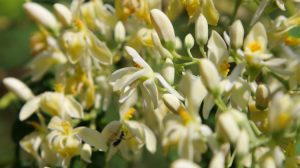16

Moringa
Moringa, Moringa oleifera, is a species of genus Moringa in the Moringaceae family. It is a fast-growing, drought-resistant tree native to the foothills of the Himalaya in Northwestern India. However, it is now cultivated in many tropical and subtropical regions around the world.
Moringa grows to a height of 32-40 feet. Its bark is grayish white, while its five-petaled flowers are yellow and white, and grow on slender branches. It contains long, hanging fruit pods that contain several dark brown seeds. Moringa also goes by the names drumstick tree, horseradish tree, and benzoil tree.
Moringa trees love the sun and heat and grow in drier conditions that other plants and trees cannot survive in. According to the USDA, it grows in hardiness zones 9 and 10 in the U.S.
Parts of the moringa tree that are used for food include its seed pods, leaves, mature seeds, oil pressed from the seeds, and its roots. However, the leaves are the most nutritious part, and are often cooked, eaten raw, or dried and ground into a powder.
Moringa Benefits
Moringa contains high amounts of vitamins A, C & K, iron, magnesium, protein, and several B vitamins. It contains 18 amino acids and all 9 essential amino acids, making moringa a wonderful source of complete protein for vegetarians. And it contains an abundance of antioxidants that contribute to cellular health by combating the damaged caused by oxidative stress.
One of the things that makes moringa special is that it contains high amounts of numerous vitamins and minerals, rather than just one or two, which is generally the case. It has …
- 4 times more vitamin A than carrots
- 4 times more potassium than bananas
- 4 times more calcium than milk
- 25 times more iron than spinach
- 36 times more magnesium than eggs
- 50 times more vitamin B3 than peanuts
The combination of high levels of calcium and magnesium are important, as magnesium is needed to help the body absorb the calcium. Plus magnesium is one nutrient most of us are deficient in.
Moringa is a potent antifungal, antibacterial, anti-inflammatory, and it has anti-diabetic effects, as it helps to balance blood sugar by reducing blood glucose levels. Moringa also has anti-tumor and anti-cancer properties, in part because of a compound called niaziminin, which studies have also shown to be a potential treatment for the Epstein-Barr virus.[83]
It seems science is catching up to traditional medicine regarding the health benefits of moringa. Benefits that include …
- Increasing energy levels
- Improving focus and concentration
- Lowering blood pressure
- Improving digestive health
- Balancing cholesterol levels
- Improving cardiovascular health
- Improving liver function
- Enhancing the health of skin and hair
- Protecting against neurodegenerative diseases
- Improving bone health
This seems to be merely the tip of the iceberg when it comes to moringa benefits. And a lot of these benefits come from the superior nutrient density of this superfood, as this 2014 study discovered.[84] It lists a wide range of vital antioxidants, vitamins, and minerals as reasons for this superiority.
Another 2014 study on the nutritional makeup of moringa found much of the same, including “profound antimicrobial, hypoglycemic and anti-tubercular activities.”[85] They also concluded that moringa improved cardiovascular health by normalizing blood glucose and cholesterol levels.
A 2013 clinical study assessing the anti-ulcer potential of moringa concluded that, “moringa significantly reduced the free acidity, total acidity and ulcer index,” and that “moringa possesses valuable anti-ulcer, anti-secretory, and cytoprotective activity.“[86]
But perhaps moringa’s greatest use will be as a treatment for cancer, as the following three studies have shown. This 2014 study showed that moringa inhibited tumor cell growth and significantly reduced cancer cell proliferation.[87] Another showed similar results, concluding that moringa was a promising treatment for lung cancer.[88]
And a third study on pancreatic cancer (a particularly deadly type of cancer) showed that moringa leaf extract inhibited the growth of pancreatic cancer cells.[89] Which was particularly important considering the best course of action thus far, chemotherapy, became less valuable over time as the tumors developed resistance to it.
I love when traditional medicine and science can support each other and come to the same conclusions, as is the case here. Check out this short, 10-minute Discovery Channel documentary for more information on this magical tree.
Moringa Uses
Keep in mind that unless you live in an area that produces moringa, you’ll likely be using it in powder form. However, moringa powder is extremely versatile. You can add it to soups, stews, rice dishes, or casseroles. Just be aware that high temperatures destroy vital nutrients, so I recommend adding moringa powder to already cooked food.
You can put moringa powder into a shaker, and use it the same way you do salt and pepper.
Moringa powder can also be made into an herbal tea, either alone or with other dried or fresh herbs. It can be an ingredient in smoothies, salad dressings, sauces, homemade mayonnaise, or added to beverages.
You can encapsulate the fine powder yourself. Or you can try this already encapsulated moringa supplement from Organic India. I used to mix it in water and drink it down, but it tasted like lawn shavings. And it didn’t mix well at all. Making it probably the first superfood I’ve had trouble taking in this way, out of several dozen.
However, if you want to be as natural as possible, Starwest Botanicals has both moringa powder and moringa leaves. I’d opt for the leaves and mix it with other tea herbs. Whenever I decide to get some more moringa, I may go that route.
Don’t forget to check out the video link above. It’s short and relevant, as most of us are deficient in so many important nutrients that moringa provides.
